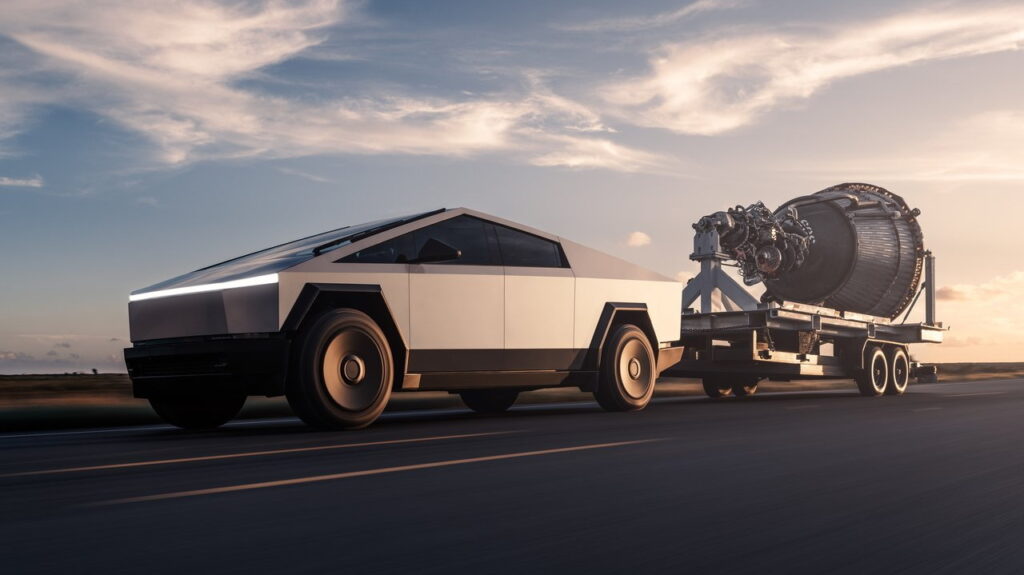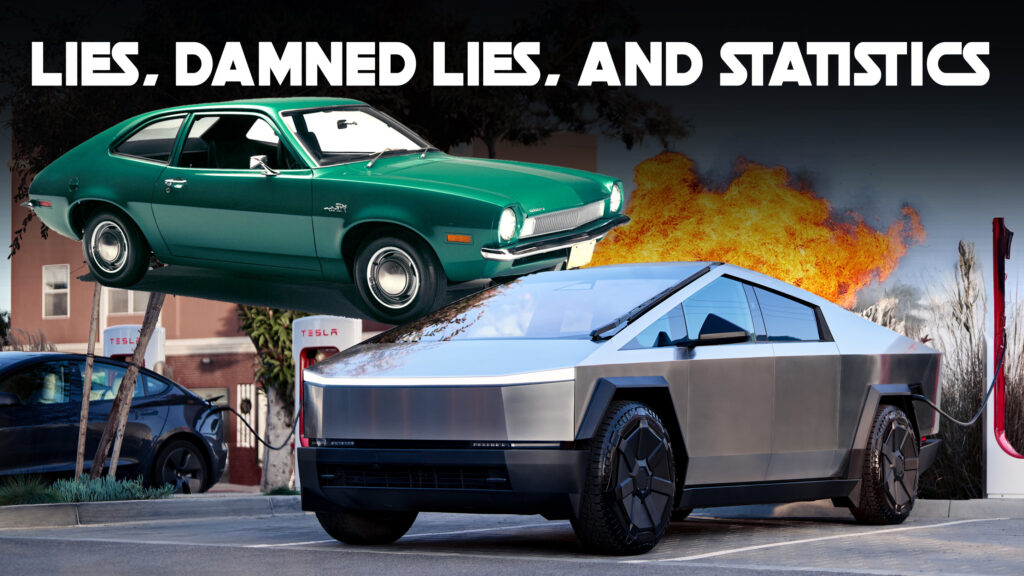- A recent report claims that the Tesla Cybertruck is more explosive than the Ford Pinto but fails to account for several things.
- For one, the small sample size of Cybertruck sales makes comparing fire statistics with the Pinto misleading.
- Despite that, the report is making the rounds online and we’re here to sort out facts from bad data reporting in the process.
The Tesla Cybertruck is about as opinion-splitting as any vehicle of the last half-century. Whether it’s getting vandalized in parking lots, receiving glowing praise from diehard fans, shedding trim pieces, or allegedly driving itself straight into a light pole, the truck seems to inspire strong reactions everywhere it goes. Along with such strong opinions come a gigaton of attention and with it, the need to be skeptical about headlines involving the truck.
More: Tesla Cybertruck Allegedly On FSD Drives Itself Into A Light Pole
One such claim comes from an article on FuelArc by a writer named Kay Leadfoot—who, incidentally, appears to be working on the site alongside an adorable dog named Raymundo Leadfoot. The piece, focused entirely on statistics, runs under the attention-grabbing headline, “It’s Official: The Cybertruck is More Explosive Than the Ford Pinto”, and has somehow made its way across multiple platforms.
In the piece, the author claims that the Cybertruck is more explosive (an important word that we’ll return to) than the Ford Pinto. Leadfoot goes even further to say that it’s 17 times more likely to have a fire fatality than a Pinto. To back up the claim, they cite five reported fatalities in the Cybertruck across three reported fires.
The Numbers Behind the Claim
Leadfoot estimates that Tesla has sold some 34,438 Cybertrucks so far which means that on average, per 100,000 units sold, 14.52 people die in a fire fatality. To be clear, in the real world, that’s five total reported fire-related fatalities across three separate events.
Conversely, we know of only 27 fire fatalities in the Ford Pinto despite some 3,173,491 sales during its ten-year production run from 1970 to 1980. That means that only 0.85 people died in the Pinto due to fire per 100,000 units sold. That, in a nutshell, is the breadth and depth of the reporting Leadfoot does.

To put it simply, this is far from objective apples-to-apples data though. First, the Cybertruck delivery figure is so small when compared to the Pinto that comparing the data is deeply problematic. For example, let’s pretend that two companies are in the business of building and starting campfires.
Business A starts and builds just one campfire while Business B builds 1,000 campfires but can only start two. Technically, Business A had a higher success rate (100% vs 0.2%) although Business B built 100 percent more fires. Comparing them is completely meaningless because of the sample size.

Flawed Data and Misleading Categorization
Next, Leadfoot includes the Las Vegas explosion as one of the three “fires” in this data which should say a lot about the study as a whole. To their credit, the author writes “I understand that last inclusion is controversial, as the driver’s burns were reportedly postmortem, so feel free to rerun these statistics without the Las Vegas incident included.” Even without that data point included, point one, the dramatically different data set sizes are important.
Read: Someone Is Selling A Truckload Of Yellow Ford Pinto Wagons For $16k Each
In addition, FuelArc’s report treats all fires as the same, when in reality, the cause of a fire actually matters quite a lot. In the case of the Pinto, fires were specifically linked to a documented design flaw (a poorly placed fuel tank that ruptured in rear-end collisions). In one fatal Cybertruck accident, the driver ran into a tree. In another, the driver veered into a ditch. And the third, well, it doesn’t even count since it was a terrorist attack.
What Does “Explosive” Actually Mean?
Finally, and mostly because we’re here already, let’s discuss the claim that the Cybertruck is more “explosive” than the Pinto. That word is important because Leadfoot claims that the reporting is “honest” and the word explosive is a specific one. Explosions are, according to the Oxford Dictionary, “a violent expansion in which energy is transmitted outward as a shock wave.”
That’s not documented in any of the Cybertruck fires save for the one in Las Vegas where literal fireworks were used and the battery itself still remained intact. Does Leadfoot honestly point out that the fireworks would’ve also exploded in say, any vehicle ever made? No. In fact, even the gas tank ruptures in the Pinto weren’t true explosions. Fuel would end up everywhere after the accident and often catch fire. Here’s an example of exactly that.
None of this is to say that the Cybertruck is completely safe or that it’s not without flaws or faults. But it is to say that catchy headlines don’t always tell the full story. In a few years, once we have data on hundreds of thousands of Cybertrucks, perhaps a serious fatal flaw will arise, and comparing the two cars will make sense. For now, this report feels more like an outlier or anomaly than good hard data to draw any real-world conclusions from.
Lies, Damn Lies, and Statistics
Mark Twain famously said that there are lies, damn lies, and statistics. That appears to be what we have here. If Leadfoot simply intended to get attention, they’ve surely done that. If they intended to write something genuinely insightful, it seems they couldn’t hit the side of a Cybertruck with a Ford Pinto if they tried. (Please don’t try this Ms/Mr Leadfoot as combined, the two cars are guaranteed to explode exactly 170% of the time they’re together… maybe.)




